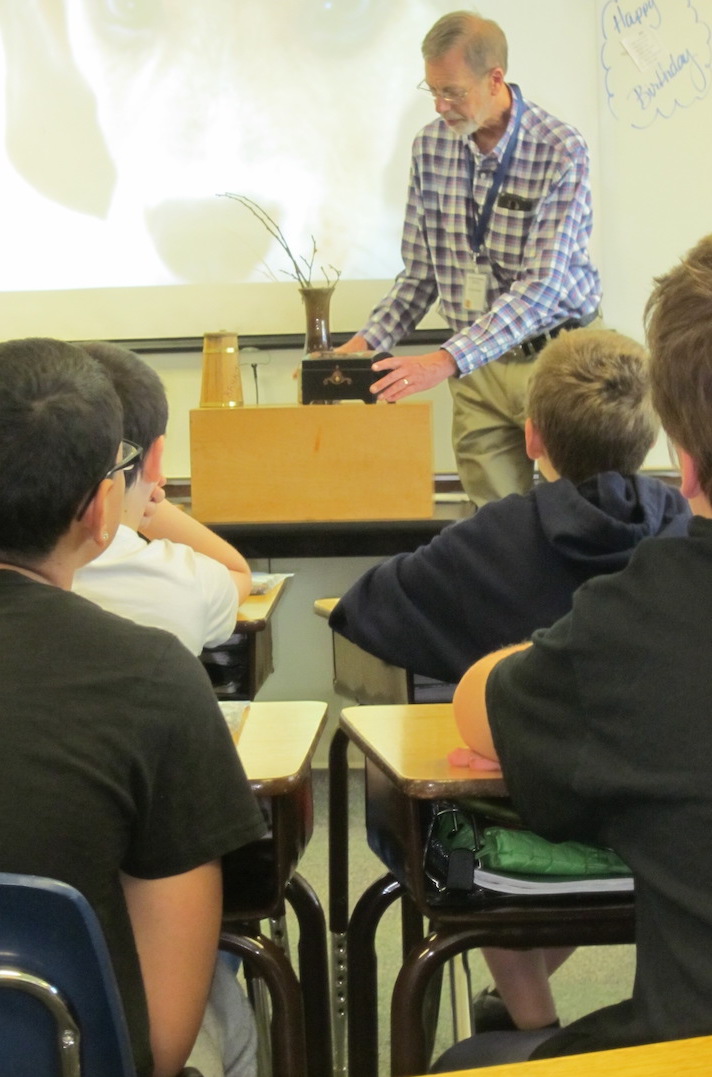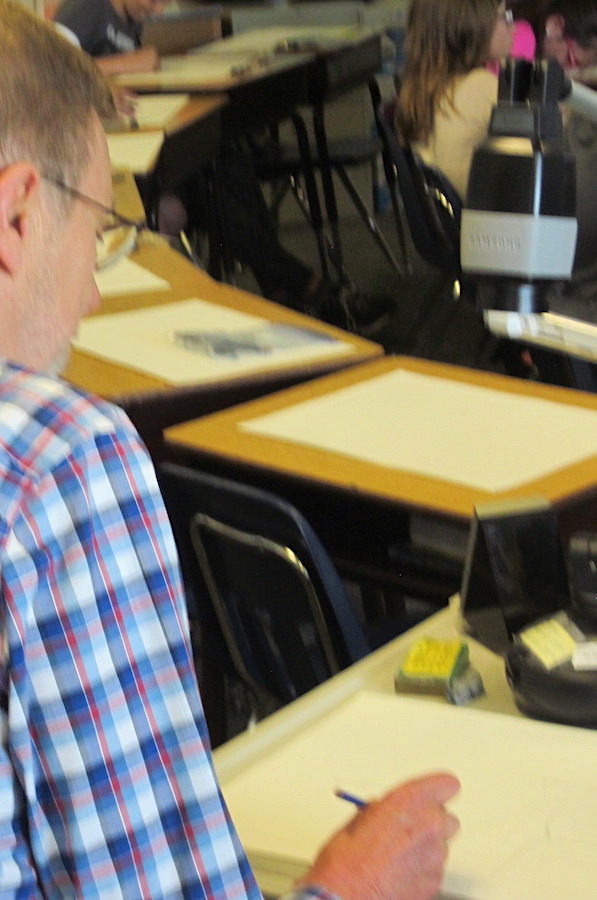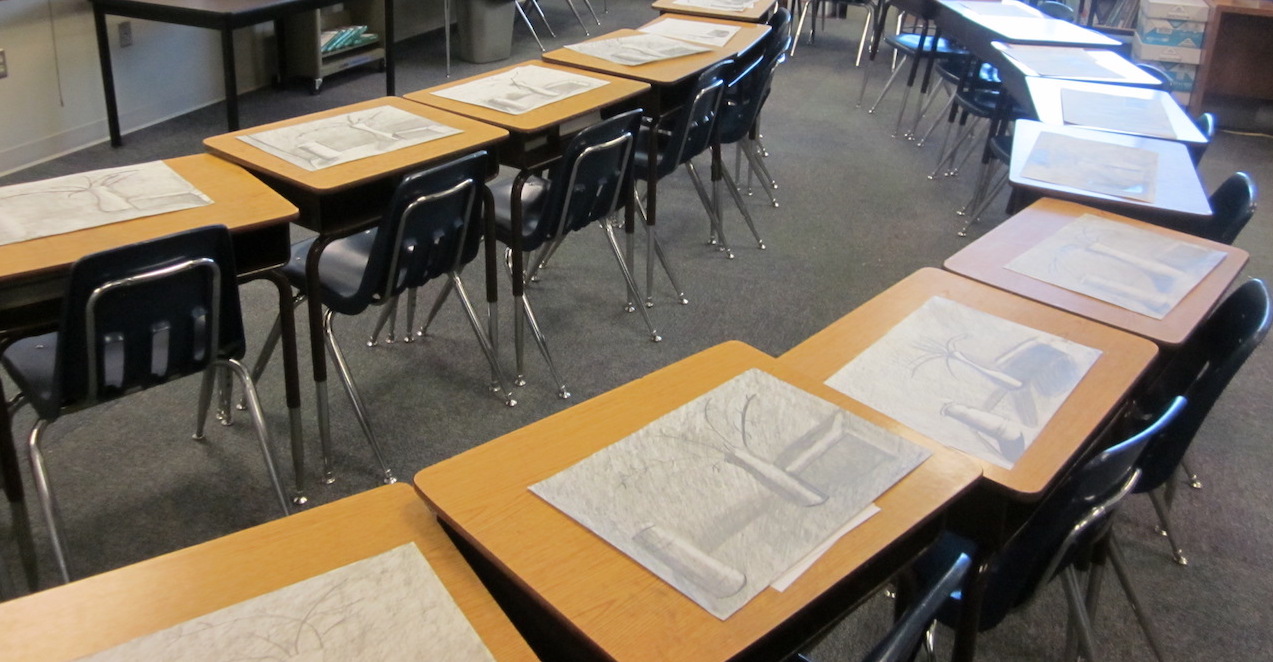The Art of Engagement
What we set out to learn and what we actually learn are often two different things. For example, have you ever gone into the library to look for some information, only to find yourself lost in a sea of interesting books that are unrelated to the book you originally searched for?
I had a similar experience a few days ago when I was invited to teach an art class to a group of sixth graders. “Teach anything you like,” the teacher said. “They’ll love whatever you do. And I’ll make sure they behave!”
It’s not often I get a chance to teach the age of kids that I write our art lessons for, so I jumped at the opportunity. I was working on a new lesson about drawing and shading a still life, and I wanted to see how some of my ideas would work with kids.
-
Would the history of still life painting be interesting to these kids?
-
Would they find arranging a still life interesting?
-
Could they handle the complexities of shading many objects?

However, although I set out to see how an art lesson idea would work, what I actually learned was something entirely different. It was the school principal who brought the lesson home to me.
The art lesson had the usual ArtAchieve art lesson sequence. We talked about the history of still life pictures, and about how some artists used a simple arrangement of ordinary objects to comment on their life and times.
We talked about some ordinary objects I had brought with me, chose three of them, and together we arranged them so all 27 kids could see them clearly. As we finished making the arrangement, one of the kids commented:
“I’m going to suck at this. This is going to be SOOO hard.”

I promised to help her through the challenge. Then, as you might expect with an ArtAchieve art lesson, we did a warmup.

Then as I sat at the back of the room drawing under the watchful eye of a camera/projector, we did a guided drawing of our arrangement. As we were doing so, the school principal came in to observe.

We talked about some simple principles of shading and then began shading the still life together - with me working under the camera and students working silently at their desks. As we did so, the principal walked over to the classroom teacher and started whispering. She was clearly excited.
A few moments later she stepped over to me and said, “We’re so glad you came. You are welcome here any time!” Then she explained what she was so excited about.
"I have NEVER seen these kids so quiet!”

Students worked with hardly a sound for an hour and thirty minutes, with one three-minute break. I had answered my questions about the lesson. The girl who said she was going to “suck” offered her paper so I could use it to review what we had tried to accomplish. She was clearly proud of her work.

It was time for students to get ready to go home. Later in the evening the teacher called and repeated what the principal had said told her. She added:
“Those kids were so focused!”
And so they were. And why shouldn’t they have been?
Visual arts classes are one of the best ways to teach kids the skill of engagement.

This class was another demonstration of a group of kids learning that skill.
Jennifer at A Peace of Mind blog recently wrote the following:
We really enjoyed the variety of lessons within this program! So many times, art is just art, and you never really see the deeper connection to the world around you. But this program really brings it all to life. You are learning so much more than you can imagine! And what impresses me most about this? My oldest son cannot focus on anything for more than a couple minutes (multi tasking ninja?) but he can sit and complete every one of these lessons (then do them again).
Her comments are a good testimony to the power of art to teach students engagement.
Don't let your students miss out on the opportunity to learn the skill of being engaged in learning!
What we set out to learn and what we actually learn are often two different things. For example, have you ever gone into the library to look for some information, only to find yourself lost in a sea of interesting books that are unrelated to the book you originally searched for?
I had a similar experience a few days ago when I was invited to teach an art class to a group of sixth graders. “Teach anything you like,” the teacher said. “They’ll love whatever you do. And I’ll make sure they behave!”
It’s not often I get a chance to teach the age of kids that I write our art lessons for, so I jumped at the opportunity. I was working on a new lesson about drawing and shading a still life, and I wanted to see how some of my ideas would work with kids.
-
Would the history of still life painting be interesting to these kids?
-
Would they find arranging a still life interesting?
-
Could they handle the complexities of shading many objects?

However, although I set out to see how an art lesson idea would work, what I actually learned was something entirely different. It was the school principal who brought the lesson home to me.
The art lesson had the usual ArtAchieve art lesson sequence. We talked about the history of still life pictures, and about how some artists used a simple arrangement of ordinary objects to comment on their life and times.
We talked about some ordinary objects I had brought with me, chose three of them, and together we arranged them so all 27 kids could see them clearly. As we finished making the arrangement, one of the kids commented:
“I’m going to suck at this. This is going to be SOOO hard.”

I promised to help her through the challenge. Then, as you might expect with an ArtAchieve art lesson, we did a warmup.

Then as I sat at the back of the room drawing under the watchful eye of a camera/projector, we did a guided drawing of our arrangement. As we were doing so, the school principal came in to observe.

We talked about some simple principles of shading and then began shading the still life together - with me working under the camera and students working silently at their desks. As we did so, the principal walked over to the classroom teacher and started whispering. She was clearly excited.
A few moments later she stepped over to me and said, “We’re so glad you came. You are welcome here any time!” Then she explained what she was so excited about.
"I have NEVER seen these kids so quiet!”

Students worked with hardly a sound for an hour and thirty minutes, with one three-minute break. I had answered my questions about the lesson. The girl who said she was going to “suck” offered her paper so I could use it to review what we had tried to accomplish. She was clearly proud of her work.

It was time for students to get ready to go home. Later in the evening the teacher called and repeated what the principal had said told her. She added:
“Those kids were so focused!”
And so they were. And why shouldn’t they have been?
Visual arts classes are one of the best ways to teach kids the skill of engagement.

This class was another demonstration of a group of kids learning that skill.
Jennifer at A Peace of Mind blog recently wrote the following:
We really enjoyed the variety of lessons within this program! So many times, art is just art, and you never really see the deeper connection to the world around you. But this program really brings it all to life. You are learning so much more than you can imagine! And what impresses me most about this? My oldest son cannot focus on anything for more than a couple minutes (multi tasking ninja?) but he can sit and complete every one of these lessons (then do them again).
Her comments are a good testimony to the power of art to teach students engagement.
Don't let your students miss out on the opportunity to learn the skill of being engaged in learning!
What we set out to learn and what we actually learn are often two different things. For example, have you ever gone into the library to look for some information, only to find yourself lost in a sea of interesting books that are unrelated to the book you originally searched for?
I had a similar experience a few days ago when I was invited to teach an art class to a group of sixth graders. “Teach anything you like,” the teacher said. “They’ll love whatever you do. And I’ll make sure they behave!”
It’s not often I get a chance to teach the age of kids that I write our art lessons for, so I jumped at the opportunity. I was working on a new lesson about drawing and shading a still life, and I wanted to see how some of my ideas would work with kids.
-
Would the history of still life painting be interesting to these kids?
-
Would they find arranging a still life interesting?
-
Could they handle the complexities of shading many objects?

However, although I set out to see how an art lesson idea would work, what I actually learned was something entirely different. It was the school principal who brought the lesson home to me.
The art lesson had the usual ArtAchieve art lesson sequence. We talked about the history of still life pictures, and about how some artists used a simple arrangement of ordinary objects to comment on their life and times.
We talked about some ordinary objects I had brought with me, chose three of them, and together we arranged them so all 27 kids could see them clearly. As we finished making the arrangement, one of the kids commented:
“I’m going to suck at this. This is going to be SOOO hard.”

I promised to help her through the challenge. Then, as you might expect with an ArtAchieve art lesson, we did a warmup.

Then as I sat at the back of the room drawing under the watchful eye of a camera/projector, we did a guided drawing of our arrangement. As we were doing so, the school principal came in to observe.

We talked about some simple principles of shading and then began shading the still life together - with me working under the camera and students working silently at their desks. As we did so, the principal walked over to the classroom teacher and started whispering. She was clearly excited.
A few moments later she stepped over to me and said, “We’re so glad you came. You are welcome here any time!” Then she explained what she was so excited about.
"I have NEVER seen these kids so quiet!”

Students worked with hardly a sound for an hour and thirty minutes, with one three-minute break. I had answered my questions about the lesson. The girl who said she was going to “suck” offered her paper so I could use it to review what we had tried to accomplish. She was clearly proud of her work.

It was time for students to get ready to go home. Later in the evening the teacher called and repeated what the principal had said told her. She added:
“Those kids were so focused!”
And so they were. And why shouldn’t they have been?
Visual arts classes are one of the best ways to teach kids the skill of engagement.

This class was another demonstration of a group of kids learning that skill.
Jennifer at A Peace of Mind blog recently wrote the following:
We really enjoyed the variety of lessons within this program! So many times, art is just art, and you never really see the deeper connection to the world around you. But this program really brings it all to life. You are learning so much more than you can imagine! And what impresses me most about this? My oldest son cannot focus on anything for more than a couple minutes (multi tasking ninja?) but he can sit and complete every one of these lessons (then do them again).
Her comments are a good testimony to the power of art to teach students engagement.
Don't let your students miss out on the opportunity to learn the skill of being engaged in learning!

